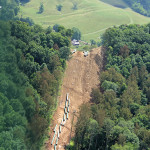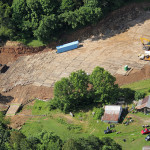One small stream in West Virginia is at the epicenter of mega pipeline construction in the central Appalachian region. If industry plans go forward, a two-mile stretch of Meathouse Fork and it’s tributaries, Big Isaac Creek and Laurel Run, will be crossed by three of the largest pipelines ever built in the region. The smaller of these, the Stonewall Gathering Pipeline (36-inches and 55 miles long), is under construction. The others, the Atlantic Coast/Supply Header Pipeline and the Mountain Valley Pipeline (up to 42-inches and 100s of miles long), are proposed and currently under review by the Federal Regulatory Commission (FERC).
The inevitable impact of these converging pipelines on the environment and people in one small area serves to emphasize the risk associated with the current rush to build more and larger pipelines for shale-gas transmission. Critical questions concerning optimal siting, potential co-location, cumulative impact, and regulatory capability have not been answered. Each project is instead planned and constructed as a separate and independent activity.
Conservation groups, concerned citizens, and elected officials have called on FERC to conduct a comprehensive assessment before authorizing the multiple big interstate pipelines proposed for moving shale gas across the Appalachian Mountains to the east coast (see Scoping Comments). A regional or programmatic EIS is needed for objective evaluation of the costs, benefits, and need. The current lack of coordinated analysis and planning does not bode well for the steep mountains, high-quality streams, sensitive water-supply areas, National Forests, and private lands in the path of the proposed pipeline projects.
The Stonewall Gathering Pipeline project clearly demonstrates the problems with the business-as-usual approach to pipeline construction. Surveillance by the DPMC’s Pipeline Air Force, inspection by the WV Department of Environmental Protection (WVDEP), and observation by local residents, reveals a lack of concern for proper installation, operation, and maintenance of basic erosion and sediment control (ESC) measures. There is no reason to believe it will be any different for the other, larger pipelines.
Precision Pipeline, LLC, the construction company that is building the Stonewall Gathering Pipeline, promotes itself in terms of environmental stewardship and professional integrity. (“We have the experience and expertise to safely complete any project while maintaining total environmental compliance with minimal impact to landowners.“)
Although environmental protection is clearly a public-relations priority for the pipeline construction industry, it’s obvious that other considerations take precedence in actual practice. Construction of the Stonewall Gathering Pipeline provides a case in point.
The contrast between the hype and on-the-ground performance is remarkable.
The Pipeline Air Force has flown and obtained aerial photographs of the construction corridor. The first flight, on June 22, revealed mountain-side construction and stream crossings with failed or missing ESC structures and apparent intentional discharge of sediment-laden water into a wetland and stream (see right sidebar and WVDEP Inspection Report and Notice of Violation, 07/07/15).
The WVDEP inspected the Stonewall Gathering Pipeline on four dates in June and July of this summer. Following those inspections, the WVDEP issued 12 Notices of Violation, citing failures:
• to prevent sediment deposition in streams
• to properly operate and maintain treatment and control systems
• to prevent sediment laden water from leaving the construction site
• to prevent impacts to streams associated with earthen slippage
The WVDEP observed many other ESC deficiencies and issued warnings related to general disregard for the local environment, citing the need to minimize exposure of construction wastes, trash, agricultural chemicals, and sanitary wastes to precipitation and stormwater, and noting that water bottles, foam detritus, and used blasting caps/detonators were observed throughout the inspected area.
The WVDEP inspection records, Notices of Violation, and related photographs can be accessed here: 06/16/15, 07/07/15, and 07/14/15-07/16/15.
The following photographs of Stonewall Gathering Pipeline construction were obtained by the DPMC Pipeline Air Force on 06/22/15:
- Trench excavation and placement of pipe.
- Washout repair. (Stonewall Gathering Line, West Virginia)
- Pipe truck on steep hillside, cabled to dozer. (Stonewall Gathering Pipeline, West Virginia)
- Equipment on steep slope, cabled to dozer. (Stonewall Gathering Line, West Virginia)
- Cut and fill, erosion and slippage.
- Pipe welding, cut banks and fill material.
- Pipe on construction corridor.
- Pipe laid on steep hillside.
- Staging for horizontal drilling under interstate.
- Stream crossing, washed-out planking, muddy water.
- Stream crossing, staging area, muddy water.
- Slope failure after apparent final grading.
Additional reports on the Stonewall Gathering Pipeline, including information on compliance enforcement, will follow.












